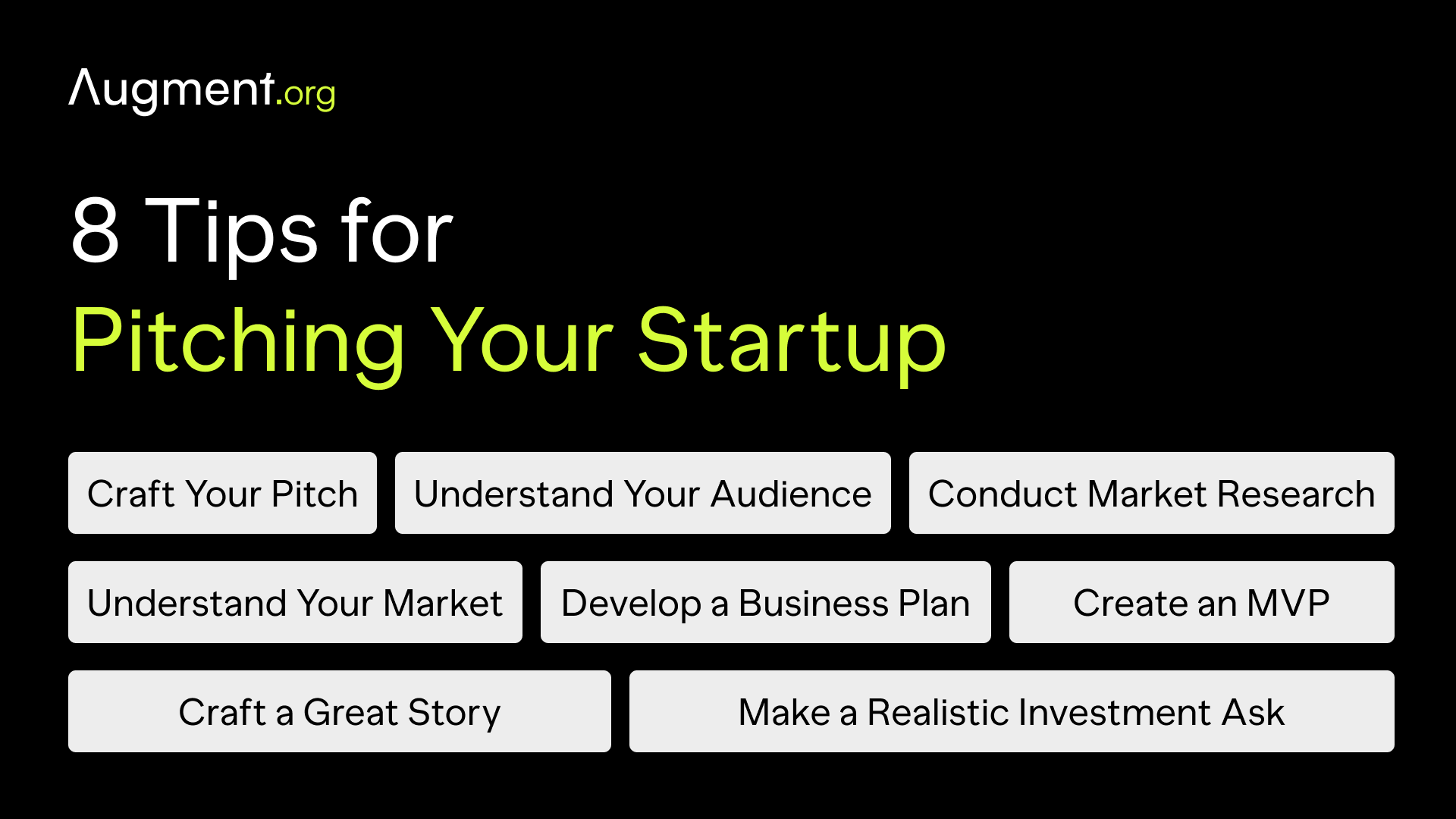How to Pitch to Investors: 8 Tips for Pitching Your Startup
Pitching to investors is a critical step for any startup seeking to secure funding. From crafting an impactful elevator pitch to developing a well-structured business plan, learn essential tips for effectively communicating your business idea to potential investors.

Why Do Investors Matter for Your Startup?
Securing investment can be a game-changer for early-stage companies. Investors bring a wealth of experience, a broad network, and valuable guidance. For startups looking to scale, attract key hires, or expand their market reach, the right investors can provide not only financial support but also strategic business advice. They help transform a compelling business idea into a viable, profitable venture.
Venture capitalists, angel investors, and professional investors often possess a deep understanding of specific industries. Their insight can help startups navigate common pitfalls, refine their business model, and tailor their marketing strategy to appeal to the target market. Investors also serve as a credibility badge, attracting further attention and investment.
8 Tips for Pitching Your Startup to Investors
Investors look for a combination of a promising business idea, a viable market opportunity, and a team that can execute the plan effectively. Your pitch is your chance to show that your startup has what it takes to succeed.
1. Craft a Compelling Elevator Pitch
An elevator pitch is a succinct, persuasive speech that serves as the first impression of your startup. It's crucial in situations where you have a brief moment to capture the interest of potential investors, like venture capitalists or angel investors. Here's how to craft an elevator pitch that leaves a lasting impact:
- Understanding the Elevator Pitch's Purpose: Your elevator pitch is designed to introduce your business idea, highlight its uniqueness, and leave the listener wanting more. It's not a detailed business plan but a teaser that opens the door for further conversation.
- Structuring Your Pitch: A good elevator pitch should include:
- Introduction: Start by introducing yourself and your business. Make it engaging and memorable.
- Problem Statement: Clearly articulate the problem or pain point your business addresses. This should resonate with your target audience and market.
- Your Solution: Describe your product or service and how it solves the identified problem. Focus on the value proposition and what sets it apart from competitors.
- Market Potential: Briefly touch on the market opportunity. This could be the size of the target market or a notable gap in the market you're addressing.
- Call to Action: End with a clear call to action. What do you want from your listener? A meeting, an investment, or another opportunity to present in more detail?
- Making It Memorable and Engaging:
- Tell a Story: Weave in a compelling story or a personal connection to the business idea. This makes your pitch more relatable and memorable.
- Keep It Simple: Avoid jargon and complex explanations. The pitch should be understandable to someone outside your industry.
- Show Passion: Your enthusiasm can be contagious. Show your passion for the business idea.
- Practicing Your Pitch:
- Rehearse Regularly: Practice your pitch until it feels natural and confident. Time it to ensure it stays within 60 seconds.
- Seek Feedback: Present your pitch to friends or mentors and ask for honest feedback. Adjust based on their suggestions.
- Tailoring Your Pitch:
- Know Your Audience: Customize the pitch based on who you are speaking to. A pitch to a venture capital fund manager might focus more on growth potential and financials, while a pitch to an angel investor might highlight the innovative aspect of your product or service.
- Using Your Pitch Effectively:
- Always be prepared to deliver your elevator pitch – you never know when an opportunity might arise.
- Use your pitch as an opener in networking events, pitch meetings, or even in casual settings where potential investors might be present.
2. Identify and Understand Your Audience
When preparing to pitch your startup to investors, one of the most crucial steps is to deeply understand your audience. This involves more than just knowing their name — it's about comprehending their investment preferences, history, and what drives their decisions. Here's how to thoroughly prepare for this:
- Researching Potential Investors:
- Investment History: Look into the types of businesses and industries they've previously invested in. This can give you clues about their areas of interest and expertise.
- Stage Preference: Determine if they usually invest in early-stage companies or more established ones. Tailoring your pitch to align with their comfort level is key.
- Industry Preference: Some investors may prefer certain industries, like technology, healthcare, or green energy. Knowing this can help you highlight relevant aspects of your business.
- Analyzing Investment Patterns:
- Track Record: Understand their successful investments and try to grasp what made those ventures attractive. This could be the business model, the market potential, or the team.
- Failure Analysis: If possible, learn about their less successful investments. Knowing what didn't work can help you avoid similar pitfalls or address potential concerns upfront.
- Customizing Your Approach:
- Tailoring Your Pitch: Once you've identified your potential investor's preferences, customize your pitch accordingly. For example, if they value innovation in technology, emphasize the innovative aspects of your product or service.
- Value Proposition: Align your startup's value proposition with what you've learned about the investor. For instance, if they're keen on high growth potential, focus on your market size and growth strategy.
- Understanding the Role of Venture Capitalists and Angel Investors:
- Venture Capitalists: They often look for scalable and high-growth business models, so emphasize aspects like your market opportunity, potential for customer acquisition, and plans to achieve profitability.
- Angel Investors: They might be more interested in the personal story behind your business and its potential impact. Highlight your passion, commitment, and the problem your startup is solving.
- Preparing for Different Scenarios:
- Questions and Objections: Based on your research, prepare for specific questions or objections that the investor might have. Being well-prepared shows that you understand their perspective and have done your due diligence.
- Presentation Style: Adjust your presentation style to match the investor's personality. Some may prefer a formal and detailed approach, while others might appreciate a more conversational and succinct presentation.
- Building a Relationship:
- Beyond the Pitch: Remember, pitching to investors is not just about securing funding; it's about starting a relationship. Show that you value their expertise and input, not just their capital.
- Long-term Potential: Convey the long-term potential of your partnership with them. Investors are more likely to engage if they see a benefit beyond just financial returns.
3. The Importance of In-depth Market Research
Conducting thorough market research is a cornerstone of a successful pitch to investors. It's not just about proving there's a demand for your product or service, but also about demonstrating your understanding of the market dynamics, trends, and competitive landscape. It is about demonstrating how your startup can capture value for them as investors. Here's how to delve deep into market research for a compelling investor pitch:
- Identifying Your Target Market:
- Demographics and Psychographics: Determine who your potential customers are, including their age, gender, income level, lifestyle, and behavior. This helps in tailoring your product or service to meet their specific needs.
- Needs and Preferences: Understand the needs, preferences, and pain points of your target audience. What problems do they face that your product or service can solve?
- Analyzing Market Size and Trends:
- Total Addressable Market (TAM): Calculate the TAM to show the overall revenue opportunity available for your product or service.
- Segmented Market Analysis: Break down the TAM into segments you can realistically target (Serviceable Available Market - SAM) and aim to capture (Serviceable Obtainable Market - SOM).
- Market Trends: Keep abreast of current and future trends that could impact your market. This shows investors you are thinking ahead and preparing for changes.
- Competitive Analysis:
- Identifying Competitors: List your direct and indirect competitors. Understand their strengths, weaknesses, market share, and value proposition.
- Competitive Advantage: Clearly articulate your competitive edge. What makes your product or service better or different? This could be technology, cost, customer service, or innovation.
- Market Positioning: Explain how you plan to position your product or service in the competitive landscape.
- Backing Claims with Data:
- Use Reliable Sources: Leverage data from credible sources like market research reports, industry analyses, and reputable journals to back your claims.
- Key Metrics: Include key metrics relevant to your market, such as market growth rate, customer acquisition costs, and average revenue per user.
- Understanding Customer Acquisition:
- Customer Acquisition Strategy: Detail how you plan to acquire customers. This could include direct sales, marketing strategies, partnerships, and digital channels.
- Customer Acquisition Costs (CAC): Estimate the cost to acquire a new customer and how this will impact your business model and profitability.
- Presenting Financial Projections:
- Realistic Projections: Use your market research to provide realistic and data-backed financial projections. This should include projected revenue, expenses, and a path to profitability.
- Sensitivity Analysis: Show how changes in the market could affect your projections. This demonstrates thorough planning and risk assessment.
- Addressing Potential Investor Questions:
- Be prepared to answer detailed questions about your market research during your pitch. Investors may probe into your methods, sources, and assumptions, so it’s crucial to be well-prepared.
4. Present Market Size and Potential
A crucial aspect of your pitch to investors is the clear demonstration of the market size and potential for your startup. This analysis involves quantifying the opportunity in the market and showcasing how your business is positioned to capture and grow its market share. Here’s a deep dive into understanding and presenting these concepts:
- Understanding Market Size Metrics:
- Total Addressable Market (TAM): TAM represents the overall revenue opportunity available or the total market demand for your product or service. Calculate it by identifying all potential customers and multiplying by the average revenue per user (ARPU). For example, if you're pitching a new educational app, your TAM would be the total number of potential users (e.g., students) multiplied by the expected subscription cost.
- Serviceable Available Market (SAM): SAM narrows down TAM to the segment you can actually reach and serve. It considers geographical limitations, distribution channels, and target audience. Continuing with the educational app example, your SAM might focus on students in a specific region or age group that you can realistically target at launch.
- Serviceable Obtainable Market (SOM): SOM is your short-term target market share within the SAM. It's a realistic goal of what you aim to capture with your current business model and marketing strategy. SOM should reflect a deep understanding of customer acquisition costs, direct sales strategies, and initial marketing efforts.
- Presenting Market Size and Potential:
- Use Reliable Data: Back up your market size figures with data from credible sources like industry reports, market research studies, and verified databases. This adds legitimacy to your claims.
- Growth Trends and Potential: Beyond current market size, investors are interested in growth potential. Highlight trends that suggest market expansion, like increasing adoption rates, technological advancements, or regulatory changes favoring your product or service.
- Visual Representation: Utilize charts and graphs in your pitch deck to visually represent TAM, SAM, and SOM. This makes the data more accessible and easier to understand for investors.
- Connecting Market Size to Your Business:
- Linking to Your Business Model: Clearly show how your business model aligns with the market opportunity. For instance, if your educational app uses a subscription model, demonstrate how this taps into the growing preference for digital learning.
- Revenue Projections: Use the market size data to justify your financial projections. Explain how you plan to capture your SOM and grow it over time, leading to sustainable revenue streams.
- Addressing Market Challenges: Acknowledge any challenges or barriers in capturing your market share and discuss your strategies to overcome them. This could include plans for innovation, scaling operations, or adapting to market changes.
- Preparing for Investor Questions:
- Anticipate Inquiries: Be ready for potential investor questions regarding your market analysis. They might ask about the sources of your data, the assumptions behind your calculations, or how external factors could impact the market size.
- Show Industry Insight: Investors appreciate when entrepreneurs display in-depth knowledge of their industry. Discuss potential shifts in the market, such as new technologies or changing consumer behaviors, and how your startup is well-positioned to adapt.
5. Develop a Comprehensive Business Plan
Creating a detailed business plan is vital for convincing potential investors, like venture capitalists or angel investors, of your startup's viability. Here’s how to develop a comprehensive plan that covers all critical aspects of your business:
- Business Model Explanation:
- Value Proposition: Clearly define what makes your product or service unique and how it addresses a specific pain point or market need.
- Revenue Model: Detail how your business will make money. Will it be through direct sales, a subscription model, advertising, or a combination of these?
- Cost Structure: Outline your major costs, including production, marketing, staff salaries, and operational expenses. This helps in understanding your financial needs and pricing strategy.
- Marketing Strategy Development:
- Target Audience Identification: Describe your specific audience, including demographic and psychographic details. This shows investors you know who your customers are and how to reach them.
- Marketing Channels: Outline the channels you'll use for customer acquisition, such as social media, online advertising, email marketing, or direct sales. Explain why these channels are the best fit for reaching your target market.
- Growth Strategy: Present your strategy for market penetration and expansion. How will you scale your business? This could include plans for new product lines, entering new markets, or leveraging partnerships.
- Financial Projections and Analysis:
- Sales Forecast: Provide a sales forecast for the next 3-5 years. This should be based on realistic assumptions about market growth, customer acquisition, and scaling of operations.
- Profit and Loss Projections: Present detailed profit and loss projections that account for expected revenue and costs.
- Break-Even Analysis: Include a break-even analysis to show when your business will become profitable.
- Milestones and Timelines:
- Short-Term Milestones: Set clear short-term goals for the first 1-2 years. This could include product development milestones, customer acquisition targets, revenue goals, and ensuring team alignment on these objectives.
- Long-Term Goals: Outline your vision for the next 5-10 years. This helps investors understand your commitment to long-term growth and sustainability.
- Timeline: Provide a timeline that maps out when you expect to achieve these milestones. This should be realistic and align with your financial and marketing strategies.
- Addressing Investor-Specific Concerns:
- Exit Strategy: Detail your exit strategy, which could involve an acquisition, IPO, or other means. This is particularly important for venture capital firms and high net worth individuals who typically seek a return on their investment within a certain timeframe.
- Risk Management: Discuss the risks your business might face and how you plan to mitigate them. This includes market risks, competitive risks, and operational risks.
- Due Diligence Readiness: Be prepared for due diligence by having all necessary documents and data organized and accessible. This includes legal documents, financial records, and detailed market research.
6. Demonstrating Your Product: The Power of a Great Demo
A well-executed product demonstration can be a game-changer in your pitch to investors. It provides a tangible, firsthand look at what you're offering, showcasing its functionality, features, and potential impact. Here’s how to make your demo a key part of your successful pitch:
- Planning Your Demo:
- Focus on Key Features: Identify the most compelling features of your product or service. What are its unique selling points? Concentrate on these features during the demo.
- Solve a Problem: Demonstrate how your product or service solves a specific problem. This could be a common pain point for your target audience or a gap in the current market.
- Prepare for Technicalities: Ensure that your product is in perfect working order. If it's a digital product or service, confirm that all technical aspects, like software or internet connectivity, are stable and reliable.
- Engaging Your Audience:
- Interactive Experience: If possible, make the demo interactive. Allow the investors to use the product or engage with the service. This hands-on experience can make a lasting impression.
- Tell a Story: As you demonstrate, weave in a narrative. How did the idea come about? What has the journey been like? This can make the demonstration more engaging and relatable.
- Anticipating Questions and Concerns:
- Common Queries: Be prepared to answer common questions about your product or service. These might include inquiries about its development, scalability, or how it compares to existing solutions.
- Addressing Concerns: Think about potential concerns or objections that investors might have and address them proactively during the demo. This shows thorough preparation and understanding of your product’s market fit.
- Financial Aspects:
- Revenue Model: Explain how the product or service will generate revenue. Is it through direct sales, subscription, or another model?
- Growth Potential: Discuss the growth potential of your product or service. How will it help achieve profitability? What are the future opportunities for expansion?
7. Use Your Pitch Deck Effectively, Not as a Script
Your pitch deck is an essential tool in the investor pitch process, but it's crucial to use it effectively. It should aid your presentation, providing visual support and emphasis to your spoken words, rather than dictating them. Here's how to make the most of your pitch deck while maintaining a personal and engaging connection with your audience:
- Designing an Effective Pitch Deck:
- Clarity and Simplicity: Each slide should be clear and straightforward, focusing on one idea at a time. Avoid cluttering slides with too much text or complex graphics.
- Visual Appeal: Use high-quality images, charts, and graphs to make your points visually appealing. This helps in keeping the investors engaged and makes your presentation more memorable.
- Brand Consistency: Ensure that your pitch deck reflects your brand’s visual identity, including colors, fonts, and overall style. This creates a professional and cohesive image of your business.
- Complementing Your Narration:
- Highlight Key Points: Use the slides to emphasize the most important points of your presentation, such as your value proposition, market opportunity, and growth strategy.
- Storytelling: Let your pitch deck aid the story you are telling. For example, if you're discussing your journey, use timelines or images that complement your narrative.
- Data Visualization: When presenting data, like financial projections or market size, use charts and graphs for easier comprehension. This can make complex information more accessible.
- Engaging with Your Audience:
- Eye Contact and Body Language: Maintain eye contact with your audience and use open body language. This helps in building a connection with the investors and keeps them engaged in your presentation.
- Interactive Discussion: Encourage questions and discussions during your pitch. This interaction makes the session more dynamic and allows you to address specific investor concerns.
- Anticipating Investor Reactions:
- Prepared Responses: Be ready to expand on any slide if an investor shows particular interest or asks a question. Have additional information at hand that might not be on the slide but is relevant to the discussion.
- Handling Questions: If a question arises that relates to a later part of your presentation, you can quickly navigate to the relevant slide to use it as a visual aid in your explanation.
- Practice and Rehearsal:
- Run-Throughs: Practice your presentation with your pitch deck multiple times. This helps in ensuring smooth transitions between speaking and using the deck.
- Feedback: Get feedback on your pitch deck and presentation style from mentors or peers. They can provide insights on how well your deck complements your presentation.
8. Make a Realistic Investment Ask
When pitching to potential investors, determining the right amount of funding to request is a critical component of your strategy. A realistic investment ask reflects a deep understanding of your business needs, market norms, and investor expectations. Here's how to approach this vital aspect of your pitch:
- Researching Market Norms:
- Industry Standards: Understand the typical funding amounts for startups in your industry. This can vary widely between sectors, such as tech, healthcare, or retail.
- Stage of Your Business: Consider the stage of your business - whether it's a concept, early stage, or growth stage. Funding needs and investor expectations will differ at each stage.
- Historical Data: Look at the funding history of similar companies. This information can often be found in industry reports, investment databases, or business news.
- Understanding Your Business Needs:
- Financial Projections: Develop detailed financial projections that include expected revenue, expenses, and cash flow. This will help determine how much funding is necessary to achieve your business goals.
- Use of Funds: Clearly articulate how you plan to use the investment. Break it down into categories like product development, marketing, hiring key staff, or scaling operations.
- Growth Strategy: Align your funding request with your growth strategy. If you’re planning to enter new markets or develop new products, ensure the requested funds will adequately cover these plans.
- Considering Investor Perspectives:
- Venture Capitalists and Angel Investors: Understand the differences in expectations between different types of investors. Venture capitalists might be interested in larger, scalable investments, while angel investors may be open to smaller, early-stage funding.
- Return on Investment (ROI): Be prepared to discuss the potential ROI. Investors want to see that you have a clear plan for how their investment will contribute to significant growth and profitability.
- Exit Strategy: Include your long-term exit strategy in your pitch, as this can impact the investor’s decision. Whether it's an acquisition, merger, or IPO, this strategy should align with the investment amount you’re asking for.
- Pitching the Ask:
- Confidence and Justification: Present your funding request confidently and back it up with solid reasoning. Make it clear that you’ve done your homework and understand what it takes to grow your business.
- Flexibility: While you should have a specific number in mind, be open to negotiation. Investors may offer different amounts or terms than what you initially requested.



